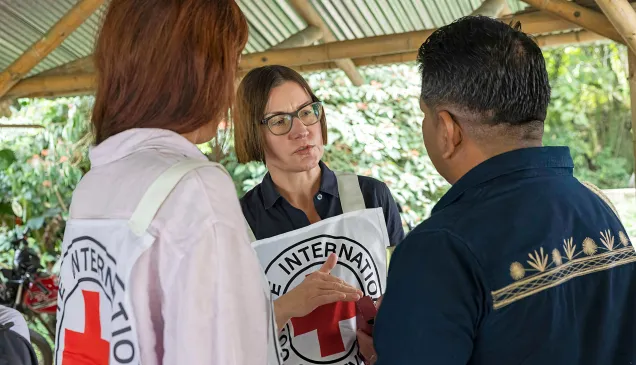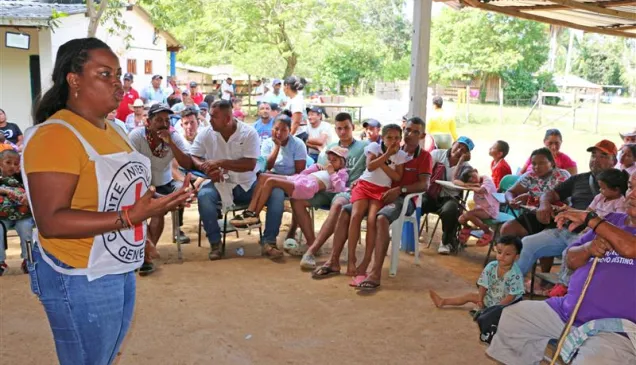Confinement, displacement and disruption of livelihoods
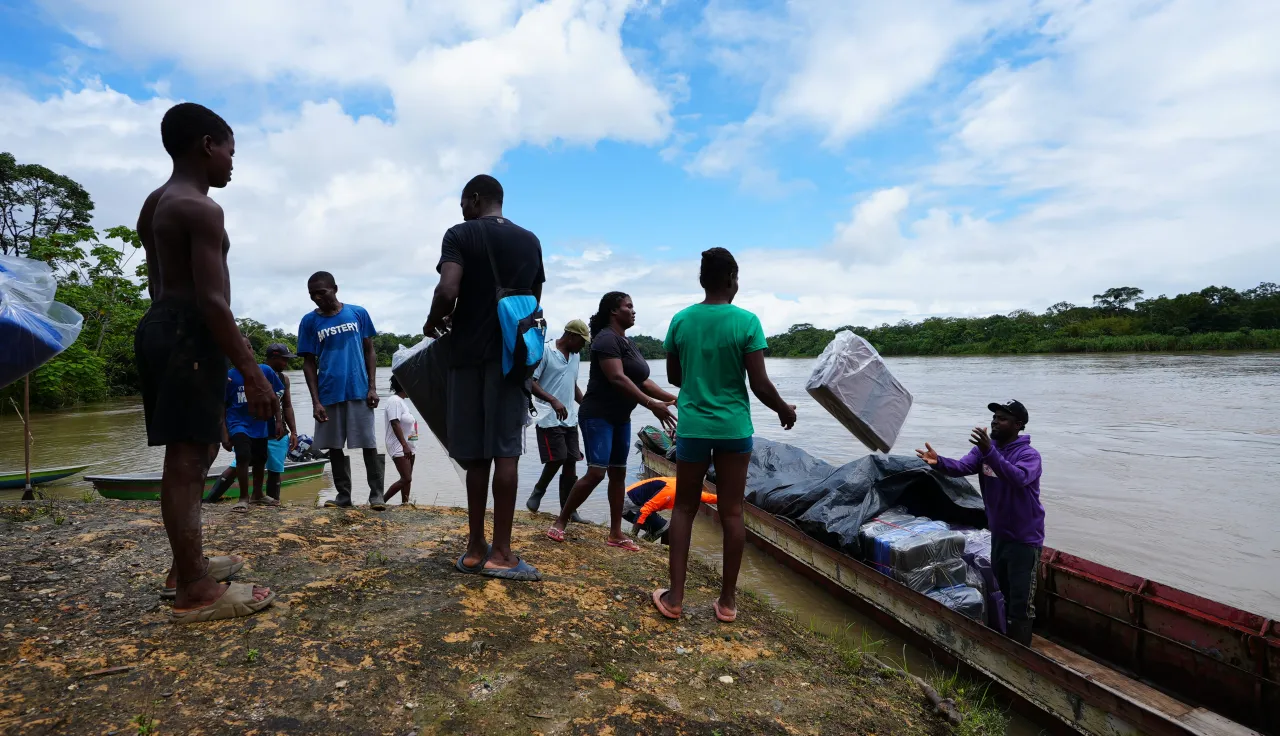
In 2024, community confinement in Colombia became more widespread than at any time in the last eight years. Confinement events increased by 102 per cent, and the affected population grew by 89 per cent compared with the
previous year.
According to figures from the Comprehensive Victim Support and Reparation Unit,* 88,874 people were confined in 12 departments of the country over the course of the year. In some cases, communities were confined because of direct threats from armed groups; in others, they adopted protective measures, including limiting mobility, due to the risk of confrontations or the presence of explosive hazards in the area.
These confinements prevented civilians from accessing basic necessities, such as food and health services. This had several effects. In some cases, it harmed people's physical and mental health. It also drastically reduced safe access to water and basic sanitation, which increased levels of vulnerability. A territorial analysis shows that confinement was most common in the Colombian Pacific region, particularly in the department of Chocó, which accounted for 41 per cent of those confined. The number of confinement events in this department rose sharply,
from eight in 2023 to 26 in 2024. Significant rises were also recorded in areas such as Antioquia, Arauca and Bolivar. In Antioquia, the population affected by confinement was more than six times larger than in 2023, making it the second most affected department in the country.
Confinement also increased in the southern departments, with the communities along the Caquetá and Caguán rivers particularly affected. The river is the main means of transport and communication and the main source of food for these communities, so being unable to travel along it profoundly affected their livelihoods and ways of life. The confinement figures for the southern areas of the country may seem low compared with other departments.
But if we take into account the isolation of the communities and the low population density of these territories, the significance of these numbers becomes clearer. In Caquetá, the population affected by confinement increased by 160 per cent from 2023 to 2024, while in Putumayo it increased by 300 per cent.
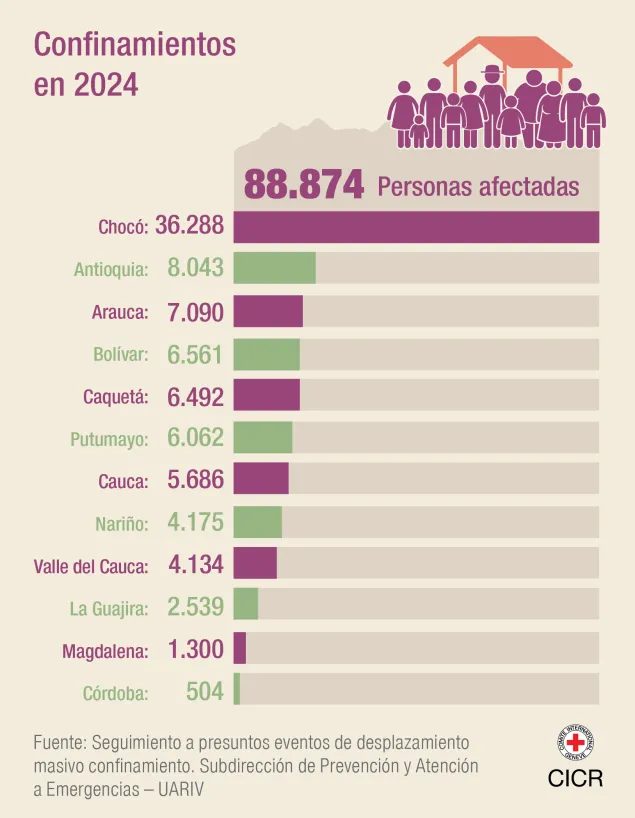
It is also important to consider the impact on ethnic communities, since 53 per cent of the people confined belonged to indigenous and Afrodescendent communities. Confinement affects these communities in several ways: it leads to a loss of autonomy, weakens their relationships with the territory, damages the social fabric and risks whole communities, and their cultures, disappearing.
This complex scenario is made worse by mass and individual displacement. In 2024, mass displacement affected 41,228 people, across 15 departments. This is fewer people than in 2023, but the overall situation has not improved. In fact, the number of mass displacement events reported increased by 34 per cent, reflecting escalating hostilities and the higher rate of threats against, and intimidation of, civilians.
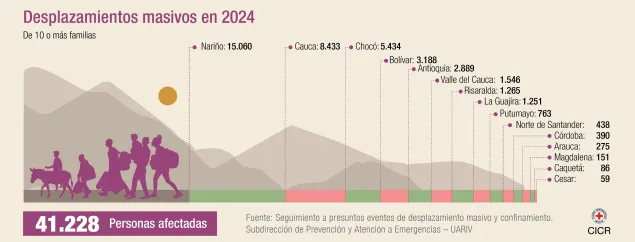
In 2024, mass displacement was so common that, every three days on average, the members of a community were forced to abandon their homes to save their lives. Each community left behind all their belongings. All they took with them was a persistent, unshakeable fear. Not only do
displaced people lose material assets, but they also suffer a profound emotional and psychological impact. Families are separated, cultures are uprooted and the future becomes uncertain.
The Nariño department experienced particularly high levels of mass displacement in 2024. Although the number of events and the size of the affected population decreased compared with 2023, Nariño remains the most affected department in the country, accounting for 36 per
cent of displaced people nationally. The situation in Cauca also stands out. In 2024, mass displacement events increased by 75 per cent compared with 2023, rising from 12 to 21. Large increases were also recorded in Antioquia and Bolivar. In Antioquia, there was an 89 per cent increase, while in Bolivar the number of events more than quadrupled, rising from three in 2023 to 16 in 2024.
Ethnic communities have been particularly affected by mass displacement. Among those displaced, 66 per cent identified as indigenous peoples or Afrodescendants, showing that these communities are particularly vulnerable to the armed conflicts. When they lose their territories, this not only affects their livelihoods, but also erodes their cultural practices and collective identity.
The rates of individual displacement were also concerning. According to the Registro Único de Víctimas (Victims Registry), between January and December 2024, 117,697 people were individually displaced. Although this figure is high, it does not reflect the true number of people affected,
as many victims do not report the event in the year it occurs, for fear of reprisals from the armed groups or because they are unaware of the state's assistance pathway.
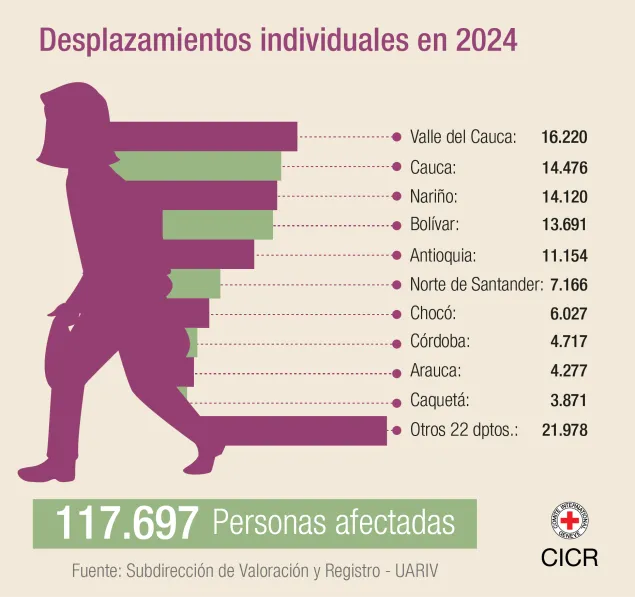
Individual displacements occurred in all 32 departments of the country, but just six departments accounted for 65 per cent of the affected people. These were Valle del Cauca, Cauca, Nariño, Bolivar, Antioquia and Norte de Santander. Among these, Valle del Cauca was the most affected; in the department, the city of Buenaventura alone accounted for 11,532 displaced people. In many cases, this kind of displacement occurs because armed groups identity individuals as targets or threaten them, leading those people to abandon their homes and seek refuge as far away as they can. Fearing for their lives, most people never return home.

